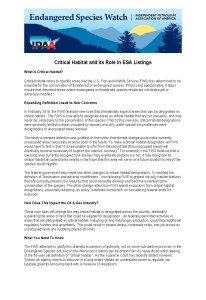What is Critical Habitat?
Critical habitat refers to specific areas that the U.S. Fish and Wildlife Service (FWS) has determined to be essential for the conservation of threatened or endangered species. When used appropriately, it helps ensure that important areas where endangered or threatened species reside are not destroyed or adversely modified.
Expanding Definition Leads to New Concerns
In February 2016, the FWS finalized new rules that dramatically expand areas that can be designated as critical habitat. The FWS is now able to designate areas as critical habitat that are not presently, and may never be, necessary to the conservation of the species. Prior to this new rule, critical habitat designations were generally limited to areas occupied by species and only under special circumstances were designations of unoccupied areas allowed.
The newly expanded definition was justified on the notion that climate change could make currently unoccupied areas necessary at some point in the future. To make a critical habitat designation, all FWS would have to find is that “it is reasonable to infer from the record that
The federal government also made two other changes to critical habitat designations. It modified the definition of “destruction and adverse modification,” now allowing FWS to protect not only habitat features that are currently present, but features that could someday develop and become essential to the conservation of the species. The other change alters how FWS grants exclusions from critical habitat designations, essentially adopting, as policy, a defacto moratorium on considering federal lands for exclusion.
How Does This Impact the Oil & Gas Industry?
These new rules will change the way critical habitat is designated across the country, drastically expanding the areas of land that could be eligible for designation. All federally permitted activities in areas that are designated as critical habitat, including oil and natural gas production, could face additional regulatory hurdles and uncertainty. This could result in project delays, increased costs, and job losses as unoccupied lands are suddenly placed off-limits.
What You Need To Know
The FWS attempts to justify this dramatic expansion of authority, not on some substantive provision in the Endangered Species Act, but on the inferences it claims can be drawn from its newly-discovered reading of the 40-year old definition of “critical habitat.” As the Supreme Court has recently stated, however, “[w]hen an agency claims to discover in a long-extant statute an unheralded power to regulate, we typically greet its announcement with a measure of skepticism.”

